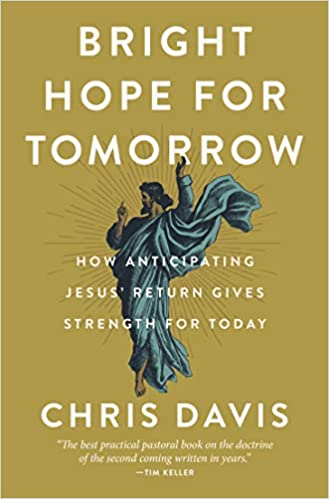A Book Review from Books At a Glance
by Ryan M. McGraw
Eschatology, or the study of the last things, carried mixed connotations for many people. Often millennial views, tribulation and rapture, and other things, hijack eschatology, drawing people away from a biblical focus on Christ himself. This practical book, aiming at a general audience, seeks to recover the Bible’s emphasis on Christ’s return in practical and life-changing ways. This good and edifying work is filled with reflections and practical real-life examples while focusing on Scripture’s teaching on the centrality of Christ’s return to Christian faith and devotion.
Davis unfolds a story about Christ’s return, which envelops the daily lives of his readers, in four progressive sections, each consisting of three to four chapters. Starting with the biblical storyline regarding the centrality of Christ’s return, he moves through various “portraits” in Scripture depicting what his second coming will be like, to three rhythms in life designed to produce patterns in which we think regularly of Christ’s return, and finally to ways in which Christ’s return changes the trajectories of our lives. Throughout, his aim is to promote self-conscious hope in Christ’s second coming (6). By way of personal reflection and experience, Davis seeks “joy, love, and longing for Jesus” in the church (14). Rather than stressing speculative views of heaven, he rightly reminds believers that Jesus himself is the heart of the gospel, whom Christians should want to see in person (26). This is precisely the tone set by the apostles, which the church needs sorely today.
Many notable features stand out, making this book helpful for Christian devotion and practice. Sometimes this consists in pithy and memorable statements, such as, “Fear without the desire to please leads to servile dread. The desire to please without fear leads to overfamiliarity, the assumption that the divine Son of God’ s commands are optional” (92-93). His work is filled with vivid and familiar illustrations as well, such as our resurrected bodies being like “something out of a fairy tale or superhero movie” (108). One of the best features of the book consists in the “rhythms” of life the author identifies, which the Lord designed to direct us continually to Christ’s return. These include public worship and the fellowship of the saints, the Lord’s Supper (128), fasting, and the weekly Sabbath. The advantage to this approach is that Davis does not merely exhort readers to think about Christ’s return, but he marks out ways in which God has already secured means to promote this mindset. Coupled with his three areas of practical application in the final section of the book, this results in an eminently practical and achievable pattern for cultivating love for Christ as we look to his future coming.
Some weaknesses stand out, nonetheless. For example, though he rightly identifies the Sabbath as “practicing for eternity” (145), he loses some of the biblical emphasis on devoting the day to God as “holy,” with an exclusive focus on anticipating heavenly worship. Holy things in the OT denoted things dedicated exclusively to God’s worship and service (e.g., Lev. 27), which is precisely why the Lord’s Day is so well-suited to foster anticipation for the coming Day of the Lord (Heb. 4:1-11). Yet Davis’ encouragement to rest from our labors and devote ourselves to worship includes activities like “watching a movie with my family” (153), which counters his overarching theme to an extent. Believers should do all things to the glory of God, thanking the Father through Christ (Col. 3:17; Eph. 5:20), but they must also learn to do the right thing, in the right way, at the right time. Although watching a movie on the Sabbath with one’s family seems like a small thing, the question is whether this activity meshes well with maximizing a day of worship to look to Christ’s return. This introduces a somewhat jarring element in an otherwise outstanding approach to developing rhythms of life revolving around the second coming. Yet occasional inconsistencies like this example should not detract from the book’s generally usefulness.
Readers desiring to get away from distracting, even sometimes obsessive, attempts to predict the future will find precisely what they are looking for here. Those filled with anxiety over an uncertain future will find the peace, hope, and rest that they need in these pages. Best of all, Davis’s book is a step in the right direction towards restoring Jesus as the core of Christian faith, hope, and love, which is the heart of the gospel itself.
Ryan M. McGraw
Greenville Presbyterian Theological Seminary
